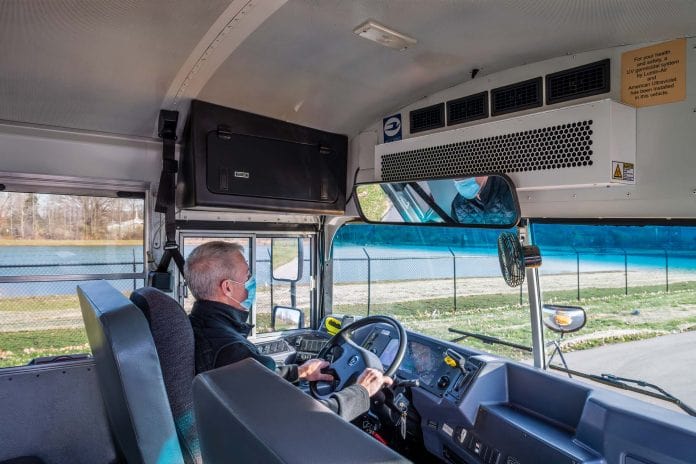
Indoor air quality in schools is finally being addressed, and that includes the air in school buses. School buses are the most densely populated areas of a school facility and they inherently have poor air quality. Funding is available through the CARES Act and the Consolidated Appropriations Act of 2021 to clean the air in school buses. Additional funding for schools is included in the American Rescue Plan.
The options available for cleaning air on school buses can be overwhelming. How do you determine what is best for your fleet?
First: Whichever solution you choose, you’re going to be questioned by the public that you serve. So, choose a technology that is recommended by the Centers for Disease Control and Prevention. The CDC recommends improving particulate filtration and using UVC. Any other technologies are considered “emerging technology without an established body of evidence.”
To quote a recent release from the American Society of Heating Refrigeration and Air Conditioning Engineers, (ASHRAE), “Technologies such as ionizers, UV-PCO, and many called by other names may claim to remove or destroy multiple types of contaminants but may convert them to other compounds that might be harmful. These technologies are designated by CDC as emerging technologies without an established body of evidence reflecting proven efficacy under as-used conditions.”
If an emerging technology claims to kill or inactivate virus and bacteria cells, how are you going to explain to people that it’s safe to put into the air that they breathe?
Second: To help consumers compare the effectiveness of various air cleaning solutions, the CDC references the EPA’s Guide to Air Cleaners in the Home. In that guide, “efficiency” and “effectiveness” are defined by the term “Clean Air Delivery Rate,” or CADR, the product of efficiency and airflow. Effectiveness takes into account how much of the air you’re cleaning. An air cleaner that is 100 percent efficient at cleaning 300 cubic feet per minute (CFM) of air would have a CADR of 300. An air cleaner that is 90 percent efficient at cleaning 1,000 CFM of air would have a CADR of 900 and be three-times as effective. A simple CADR calculator can be found at www.lumin-air.com.
Third: While your school system can get funds for the initial installation of air cleaning systems on your buses, this is one-time funding. Calculate the ongoing cost of the system. Ask vendors to include five-year parts warranties, and include five years or more of replacement filter changes in their quotes.
You’ll have to replace dirty filters with clean filters based on how quickly they reach their dust holding capacity. So, make sure vendors provide the dust holding capacity of their filters and cost of replacement filters for comparison.
To recap, ask the following questions when looking to purchase air filtration systems:
- Is the air cleaning technology endorsed by the CDC?
- Is the air cleaning technology safe and effective?
- What is the airflow (CFM) and efficiency of the air cleaning system?
- What is the dust holding capacity of the air cleaning system?
- What is the initial cost?
- What is the annual cost, considering consumable items, like replacement filters and UVC bulbs?
While it’s great that school buses are getting the attention and funding they deserve to clean the air inside school buses, it’s important to safely achieve the highest level of disinfection for the least amount of money over the lifespan of the system.
Dan Fillenwarth is managing partner of Lumin-Air. Visit www.lumin-air.com for more information.


